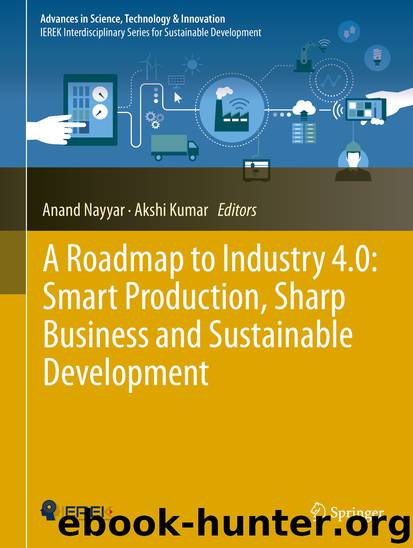A Roadmap to Industry 4.0: Smart Production, Sharp Business and Sustainable Development by Anand Nayyar & Akshi Kumar

Author:Anand Nayyar & Akshi Kumar
Language: eng
Format: epub
ISBN: 9783030145446
Publisher: Springer International Publishing
(c)Physical resource provider: The physical resource providers (PRPs) accept manufacturing data as input from the application providers and produces finished product in conformity with user conditions as output. Manufacturing equipment are owned by the PRPs having the expertise in utilizing the machines efficiently. The PRPs may be distributed over a wide range of geographic locations and are connected via cloud manufacturing network.
Fig. 17Overview of cloud manufacturing
6.2 Cloud Robotics
Robots are in use for the past few decades to help mankind to perform various difficult tasks in an efficient and precise way. In an industrial environment, they are primarily used in manufacturing units to perform tedious, repetitive or hazardous tasks in a precise manner. Use of robots provides competitive advantages by improving the product quality and reduces the cost per product while providing safety to the workers. For instance, in the automobile industry, robots are deployed for assembling, welding, painting, and packaging where human involvement otherwise would be hazardous, inefficient, and inaccurate. The networked robotic system offers an environment in which the robots are connected via wired or wireless networking topologies and are empowered to provide an improved functional range. They work in a collaborative environment to complete a task and are capable of sharing information within themselves.
Cloud robotics is a new dimension in robotics which has the potential to work beyond networked robotics. In networked robotics, the computational capabilities are limited to respective robots only, and the information sharing is restricted to the network only. Due to the advancement in cloud computing, cloud robotics has the potential to remove some of these bottlenecks and can offer more intelligent, efficient and cost-effective solutions [115]. In cloud robotics, the high complexity computing process is transferred to the cloud platform through communication networks, thereby reducing the computational load of individual robots. Figure 18 presents the system level architecture of cloud robotics. The top-level block represents the cloud infrastructure, which includes a number of high-end and proxy servers, large databases, and other associated components. The lower block comprises of various types of mobile robots, auto driven vehicles, industrial equipment, and other physical machinery as required in the present-day industry [116].
Fig. 18System level architecture of cloud robotics
Download
This site does not store any files on its server. We only index and link to content provided by other sites. Please contact the content providers to delete copyright contents if any and email us, we'll remove relevant links or contents immediately.
International Integration of the Brazilian Economy by Elias C. Grivoyannis(88430)
The Radium Girls by Kate Moore(11900)
Turbulence by E. J. Noyes(7920)
Nudge - Improving Decisions about Health, Wealth, and Happiness by Thaler Sunstein(7545)
The Black Swan by Nassim Nicholas Taleb(6989)
Rich Dad Poor Dad by Robert T. Kiyosaki(6361)
Pioneering Portfolio Management by David F. Swensen(6208)
Man-made Catastrophes and Risk Information Concealment by Dmitry Chernov & Didier Sornette(5900)
Zero to One by Peter Thiel(5661)
Secrecy World by Jake Bernstein(4619)
Millionaire: The Philanderer, Gambler, and Duelist Who Invented Modern Finance by Janet Gleeson(4352)
The Age of Surveillance Capitalism by Shoshana Zuboff(4192)
Skin in the Game by Nassim Nicholas Taleb(4144)
Bullshit Jobs by David Graeber(4067)
The Money Culture by Michael Lewis(4051)
Skin in the Game: Hidden Asymmetries in Daily Life by Nassim Nicholas Taleb(3907)
The Dhandho Investor by Mohnish Pabrai(3681)
The Wisdom of Finance by Mihir Desai(3629)
Blockchain Basics by Daniel Drescher(3474)
